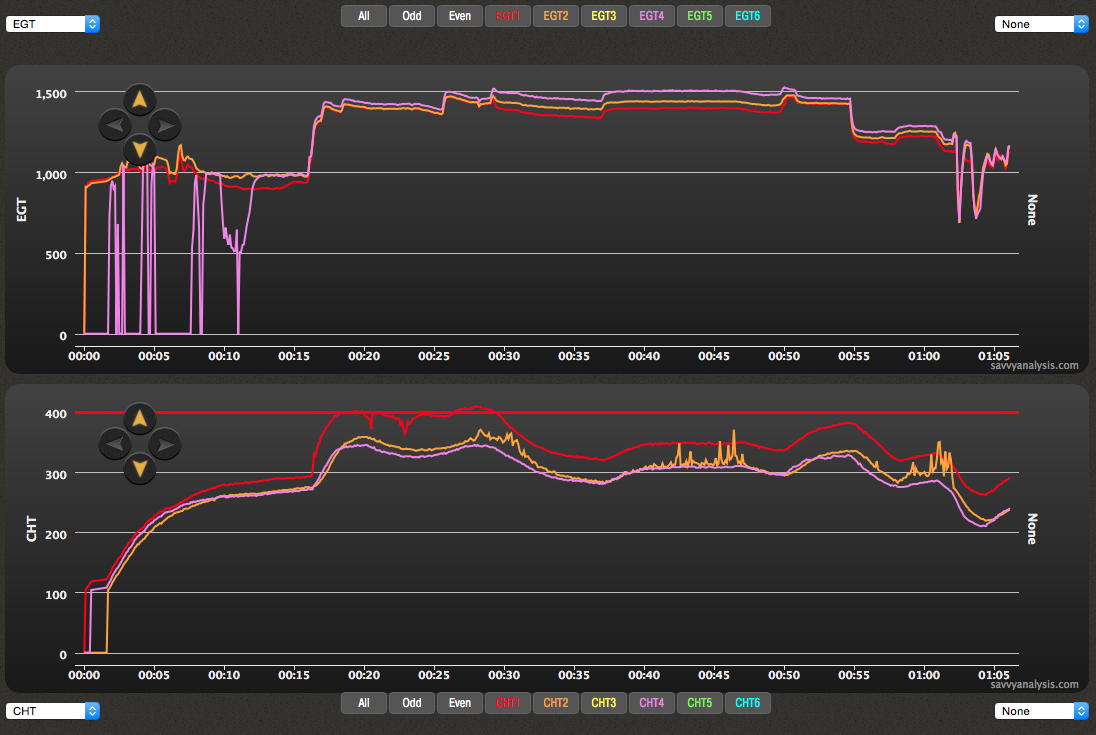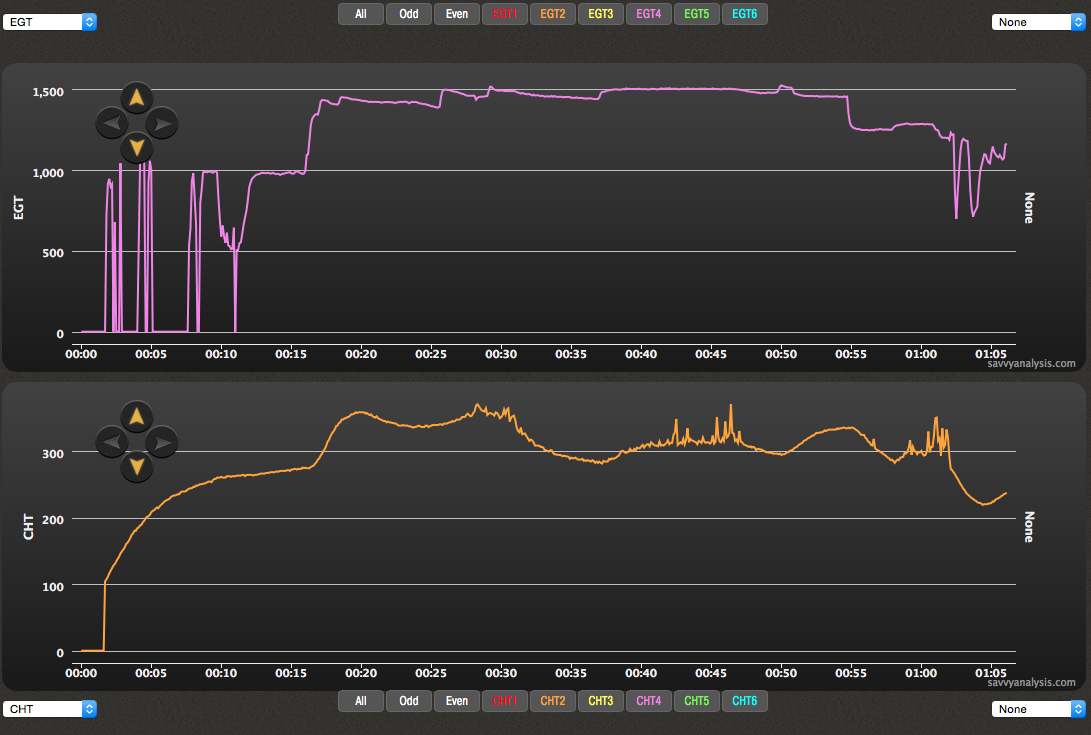Ronald Reagan used to say “Trust but Verify”. He was talking about Intercontinental Ballistic Missiles, but the philosophy works for data from engine data monitors, too. While we sit comfortably in the cockpit scanning the gauges, our data-gathering probes and cables are out there trying to work next to some hot metal in wind that qualifies as an F5 tornado. We give the data the benefit of the doubt, but sometimes the data makes us scratch our chins and look for a way to verify.
Normal, Bold, Hide and Isolate
Just like snake oil salesmen don’t start their pitch with “Everything I’m about to say is !@#$%^&”, a failing probe or a loose connection will probably keep sending data and it’s up to us to separate truth from fiction. Let’s look at some examples. Take a look at the data from this IO-550-N. No, it’s not the new 3-cylinder version – we’ve set up the chart to display only the traces for EGT and CHT 1, 2, and 4. When you notice something unusual, it helps to isolate that trace, but it also helps to include a “normal” trace for comparison. If you haven’t used the chart tools, this might be a good time to point out that the tabs with arrows let you display any parameter the EDM logs, and the buttons (All, Odd, Even etc) give you choices to highlight (bold), hide and isolate a trace. To get this display, we chose isolate for cyl 1, then normal for 2 and 4.

Which Is It?
At engine start, EGTs 1 and 2 start climbing right away, as we’d expect. EGT 4 doesn’t move. After about a minute it moves and appears to send a number similar to 1 and 2, mixed with spikes to zero. So which is it? A failing probe, a loose connection or a dead cylinder? If it were a dead cylinder, we’d expect the data to arrive with a note about how the engine almost shook itself out of the mounts, with one cylinder jumping to life and dying again, over and over. Better still, we have CHT for that cylinder which shows steady combustion through this data segment. So it looks like cylinder 4 is making power.
Now we’re down to failing probe or loose connection. Sometimes the data isn’t definitive, so here’s the decision tree. If the probe were failing, why would it start operating normally at about the 12 minute mark? It took that long to heat up? Maybe. And why would a loose connection suddenly start working? That F5 tornado behind the prop can sometimes forge a connection that was wobbly on the ground. And we’ve seen the opposite – a connection that worked on the ground stops working in the windy environment. In this case, before rushing out to replace the probe, we’d recommend checking connections first. There’s one other clue we’ll get to shortly.

CHT
At engine start, CHT 1 and 4 start climbing right away, as we’d expect. But cyl 2 doesn’t move. When it does, it acts normal through takeoff and to the first mixture pull – when EGTs rise between the 25 and 30 minute marks. Then the data gets jumpy, smooths out, then gets real jumpy. Those short bursts in CHT are almost certainly snake oil, if you think about the thermal mass of a piston and a barrel. We can see bursts like that in fuel flow, oil pressure, and electrical data, but it doesn’t ring true in a CHT trace. Plus, we look for corroboration in the EGT data and it’s not there. So here we’d probably skip the recommendation for checking connections and recommend replacing the probe. Remember that other clue? A loose connection will typically cause data dropout and readings of zero. A failing probe – depending on the probe manufacturer – may “fail high”, hoping to set off alarms on its way to probe heaven. This happens to be an Avidyne probe and they fail high – so it looks like CHT 2 is at the early stage of a fail.
Now let’s go back to the first chart and look at CHT 1. At takeoff it jumps out of the pack to the 400º redline, and stays there until the mixture pull except for two blips. So, failing probe, loose connection or actual heat? It’s rare for a probe to “sort of” fail by tracking 50º hotter. More common is for the CHT trace to jump to 500º and stay there. With a loose connection, we’d expect a mix of normal readings with dropouts, like we saw in EGT 4. This looks like heat. If it’s heat, is it combustion or cooling? If it’s combustion caused by reduced fuel flow – maybe a clogged injector – we’d expect to see EGT 1 higher than it is. This looks like uneven cooling in the engine compartment. On this engine, cylinders 1 and 2 are in the back. Those two blips could be the loose baffle readjusting in the wind. Because CHT 2 is cooler, it’s probably an intercylinder baffle around cylinder 1 – vs the silicon baffle that meets the top cowl. That would be our recommendation.
Our data-gathering probes and cables work in a hostile environment, and sometimes they stop working. But even when they’re not working properly we hope they provide some clues about where to spend our maintenance dollars to get data that we can trust.